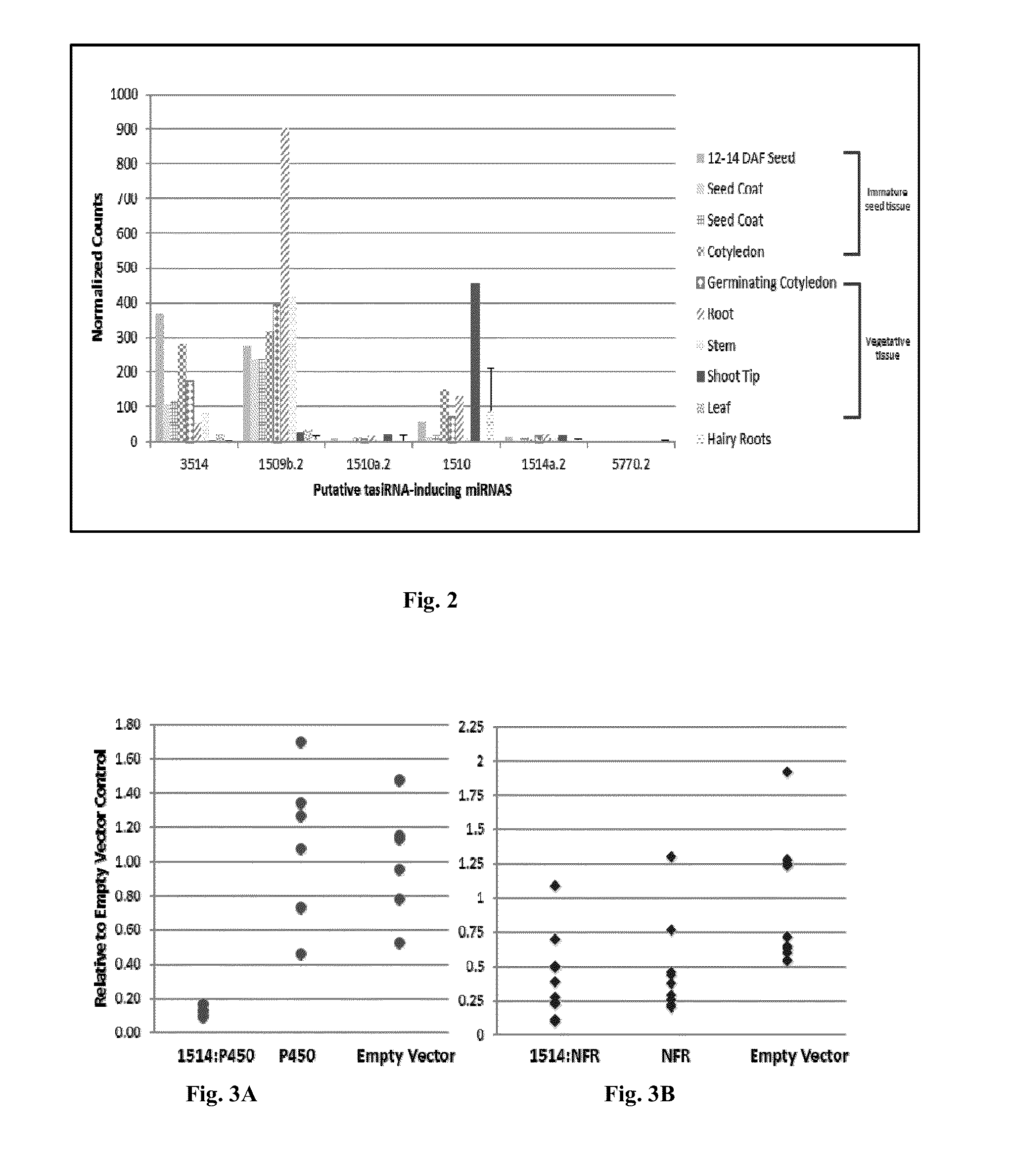Compositions and methods of gene silencing in plants
a technology of plant genes and methods, applied in the field of plant compositions and methods, can solve the problems of limited use of prevailing technology, limited mrna available for translation, and limited amount of protein produced, so as to reduce or inhibit the expression of a target gene, prevent stem breakage, and reduce the content of storage protein
- Summary
- Abstract
- Description
- Claims
- Application Information
AI Technical Summary
Benefits of technology
Problems solved by technology
Method used
Image
Examples
example 1
Identification of Putative tasiRNA Loci
Materials and Methods
[0196]Identification of Putative ta-siRNA Loci
[0197]Putative PHAS loci were identified by aligning small RNA sequences from a soybean hairy root library to the soybean genome (Glyma v1.0) with the commercial software Geneious version 5.4 (Drummond, et al., Geneious (2011)). Regions with high coverage of reads were evaluated by a number of criteria. First the sRNA reads had to be primarily 21-nt in length, consistent with DCL4 activity. Second, reads had to be from both positive and negative strands, which would indicate the presence of dsRNA. Finally a single species of sRNA (presumably a miRNA) had to align 5′ to the majority of the aligned sequences as this would indicate the possibility of a miRNA inducing the production of the siRNAs. In order to get putative miRNAs to align to the reference sequence, the miRNA alignments allowed for mismatches. PHAS loci were also identified by aligning all miRNA from fabaceae deposite...
example 2
Fusion of miR1514 Target Site Leads to Reduction of Target Transcript and Production of Secondary siRNAs Against Glyma02g43860 and Glyma07g14460
Materials and Methods
[0205]Vector Design
[0206]A modified pPZP200 vector (Covert, et al., Mycological Research 105:259-264 (2001)) was used as the binary backbone, hereafter p201N. Four vectors (1514NFR, 1514P450, NFR, and P450) were made by amplifying the 356-bp NFR1a target region and the 343-bp P450 target region using Phusion® High Fidelity Polymerase (Finnzymes). The 5′ ends of the primers contain the restriction sites Asc I and Avr II for cloning. To make the 1514a.2 fusion vectors, a 1514a.2 target site was included on the forward primer. Using traditional cloning techniques, the amplicon was inserted into a modified pPZP200 vector (Covert, et al., Mycological Research 105:259-264 (2001)) with the GmUbi promoter (Chiera, et al., Plant Cell Reports 26:1501-1509 (2007)) and rbcs terminator (An, et al., Embo Journal 4:277-284 (1985)). Vec...
example 4
Stable Transformation of Soybean with Silencing Constructs
[0232]The 1514:P450, 1514:NFR, 1514:GFP, 1510:GFP, and 1514:GUSPlus silencing vectors were transferred to a biolistic vector and shot into soybean embryogenic cultures to produce stable transgenic lines. Stable events were generated for each of the vectors. Small RNA sequencing of three 1514:P450 and three 1514:GUSPlus events confirms the production of sRNAs in leaf tissue (Table 4).
TABLE 4Stable Transformation of Soybean with Silencing ConstructsMillions ofNormalizedVectorEvent NumberCountsreadsCounts1514:GP490741.34967261514:GP2426490.71437101514:GP1240.87951514:P45012.23370.9843421514:P45018.225391.14522171514:P450206190.4071521
[0233]Unless defined otherwise, all technical and scientific terms used herein have the same meanings as commonly understood by one of skill in the art to which the disclosed invention belongs. Publications cited herein and the materials for which they are cited are specifically incorporated by refe...
PUM
| Property | Measurement | Unit |
|---|---|---|
| nucleic acid | aaaaa | aaaaa |
| resistance | aaaaa | aaaaa |
| compositions | aaaaa | aaaaa |
Abstract
Description
Claims
Application Information
 Login to View More
Login to View More - R&D
- Intellectual Property
- Life Sciences
- Materials
- Tech Scout
- Unparalleled Data Quality
- Higher Quality Content
- 60% Fewer Hallucinations
Browse by: Latest US Patents, China's latest patents, Technical Efficacy Thesaurus, Application Domain, Technology Topic, Popular Technical Reports.
© 2025 PatSnap. All rights reserved.Legal|Privacy policy|Modern Slavery Act Transparency Statement|Sitemap|About US| Contact US: help@patsnap.com



